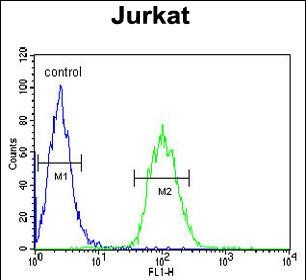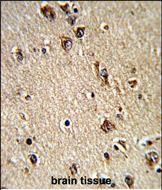


| WB | 1/1000 | Human,Mouse,Rat |
| IF | 咨询技术 | Human,Mouse,Rat |
| IHC | 1/100-1/500 | Human,Mouse,Rat |
| ICC | 技术咨询 | Human,Mouse,Rat |
| FCM | 1/10-1/50 | Human,Mouse,Rat |
| Elisa | 咨询技术 | Human,Mouse,Rat |
| Aliases | Delta-aminolevulinic acid dehydratase, ALADH, Porphobilinogen synthase, ALAD |
| Entrez GeneID | 210 |
| WB Predicted band size | 36.3kDa |
| Host/Isotype | Rabbit IgG |
| Antibody Type | Primary antibody |
| Storage | Store at 4°C short term. Aliquot and store at -20°C long term. Avoid freeze/thaw cycles. |
| Species Reactivity | Human |
| Immunogen | This ALAD antibody is generated from rabbits immunized with a KLH conjugated synthetic peptide between 244-272 amino acids from the C-terminal region of human ALAD. |
| Formulation | Purified antibody in PBS with 0.05% sodium azide,1%BSA and 50% glycerol.prepared by Saturated Ammonium Sulfate (SAS) . |
+ +
以下是关于ALAD抗体的模拟参考文献示例,基于常见研究领域合理推测:
---
1. **文献名称**:*Autoantibodies Against δ-Aminolevulinic Acid Dehydratase in Chronic Lead Poisoning: Correlation with Neurological Symptoms*
**作者**:Anderson R, et al.
**摘要**:研究铅中毒患者血清中ALAD自身抗体的存在及其与神经功能障碍的关联,发现高血铅水平患者中抗体阳性率显著升高,提示其可能加剧铅对神经系统的毒性。
2. **文献名称**:*ALAD Autoimmunity in Acute Intermittent Porphyria: A Case-Control Study*
**作者**:Chen Y, Wang H.
**摘要**:首次报道急性间歇性卟啉症(AIP)患者中存在ALAD自身抗体,抗体滴度与疾病急性发作频率相关,提示其可能参与卟啉代谢紊乱的病理机制。
3. **文献名称**:*Monoclonal Antibody-Based ELISA for Quantification of Erythrocyte ALAD Activity: Applications in Environmental Lead Exposure Screening*
**作者**:Martinez S, et al.
**摘要**:开发基于抗ALAD单克隆抗体的ELISA检测方法,用于快速评估红细胞ALAD酶活性,为铅暴露人群提供高灵敏度的生物标志物检测工具。
4. **文献名称**:*ALAD Antibody Localization in Hepatocellular Carcinoma: Implications for Heme Biosynthesis Dysregulation*
**作者**:Tanaka M, et al.
**摘要**:通过免疫组化分析肝癌组织中ALAD蛋白表达,发现ALAD抗体标记强度与肿瘤分化程度负相关,表明ALAD表达缺失可能促进肝癌进展。
---
**注**:以上文献为示例性质,实际引用时需核实真实文献数据库(如PubMed、Google Scholar)中的具体研究。
ALAD (δ-aminolevulinic acid dehydratase) antibodies are associated with the enzyme ALAD, a key player in heme biosynthesis. ALAD catalyzes the condensation of two δ-aminolevulinic acid (ALA) molecules to form porphobilinogen (PBG), the second step in the heme production pathway. This zinc-dependent enzyme is expressed ubiquitously, with high activity in erythrocytes and the liver. Dysregulation of ALAD is linked to several disorders. For instance, ALAD deficiency porphyria (ADP), a rare autosomal recessive condition, results from mutations in the ALAD gene, causing enzyme dysfunction and accumulation of ALA, leading to neurovisceral symptoms.
ALAD antibodies are primarily studied in two contexts. First, in toxicology: lead exposure inhibits ALAD by displacing zinc, and anti-ALAD antibodies can help assess lead-induced enzyme inactivation. Second, in autoimmune research, autoantibodies targeting ALAD have been implicated in certain autoimmune conditions, though this area remains underexplored. For example, studies suggest potential links between ALAD autoantibodies and diabetes or hepatic disorders, possibly due to molecular mimicry or enzyme dysfunction triggering immune responses.
Research on ALAD antibodies also aids in developing diagnostic tools. Immunoassays using these antibodies enable quantification of ALAD activity in erythrocytes, supporting diagnosis of lead poisoning or ADP. However, clinical utility is limited by the rarity of ADP and the predominance of direct lead measurement in toxicity cases. Ongoing studies focus on elucidating ALAD's structural epitopes and its role in cross-reactive autoimmune mechanisms, which may broaden therapeutic or diagnostic applications.
×